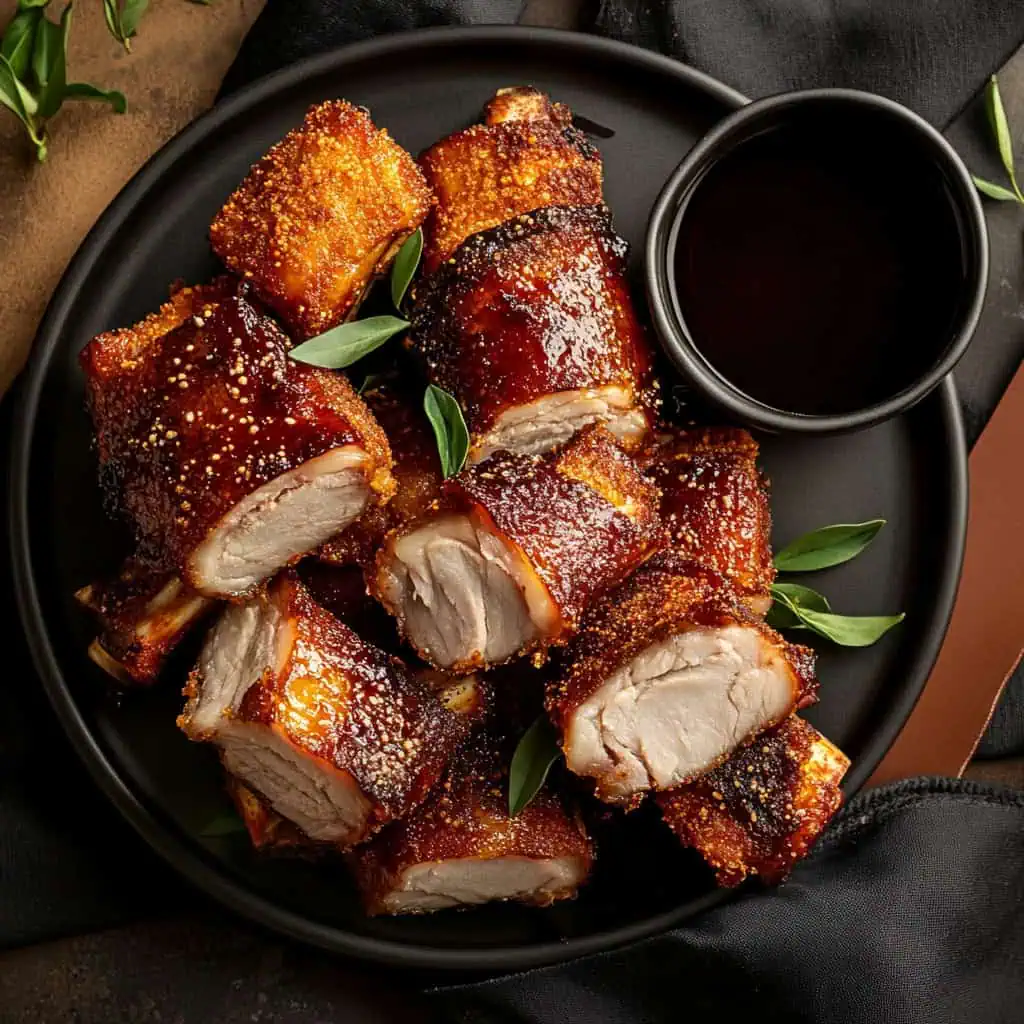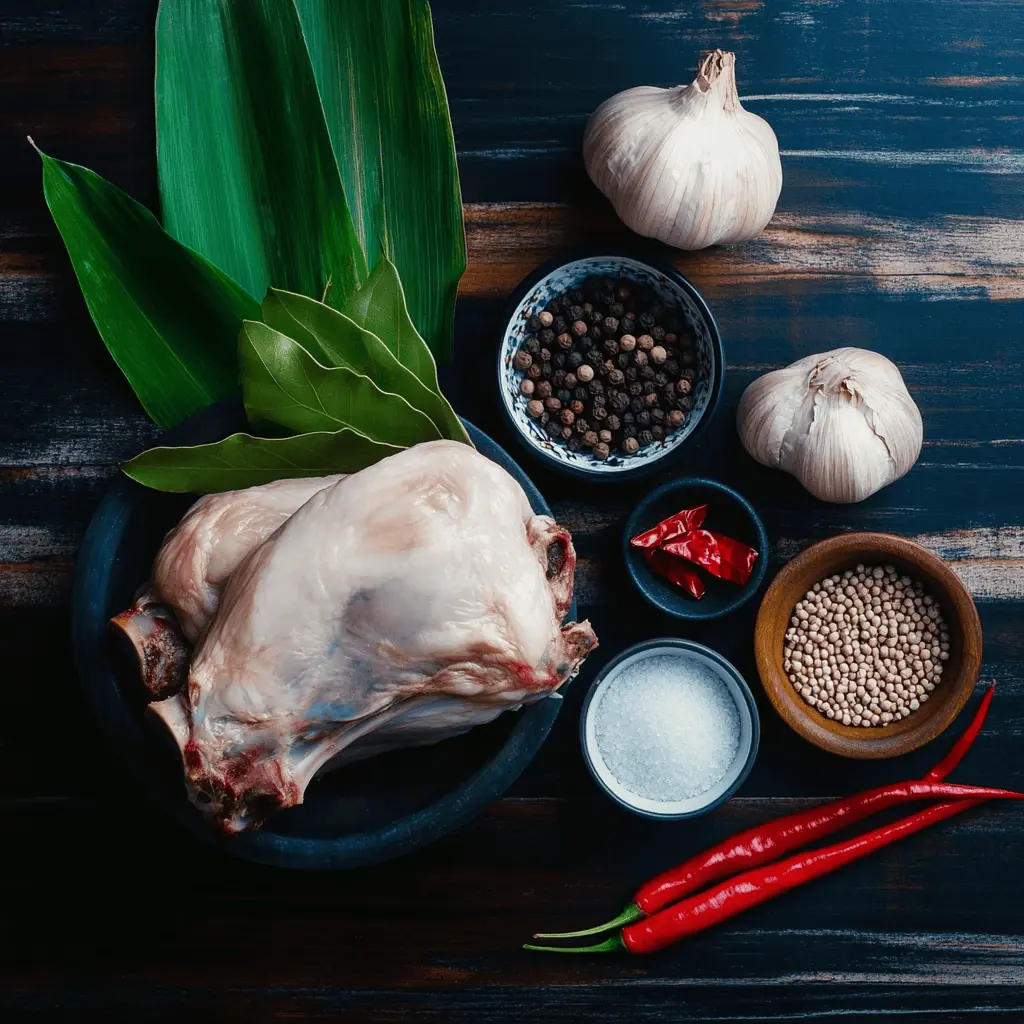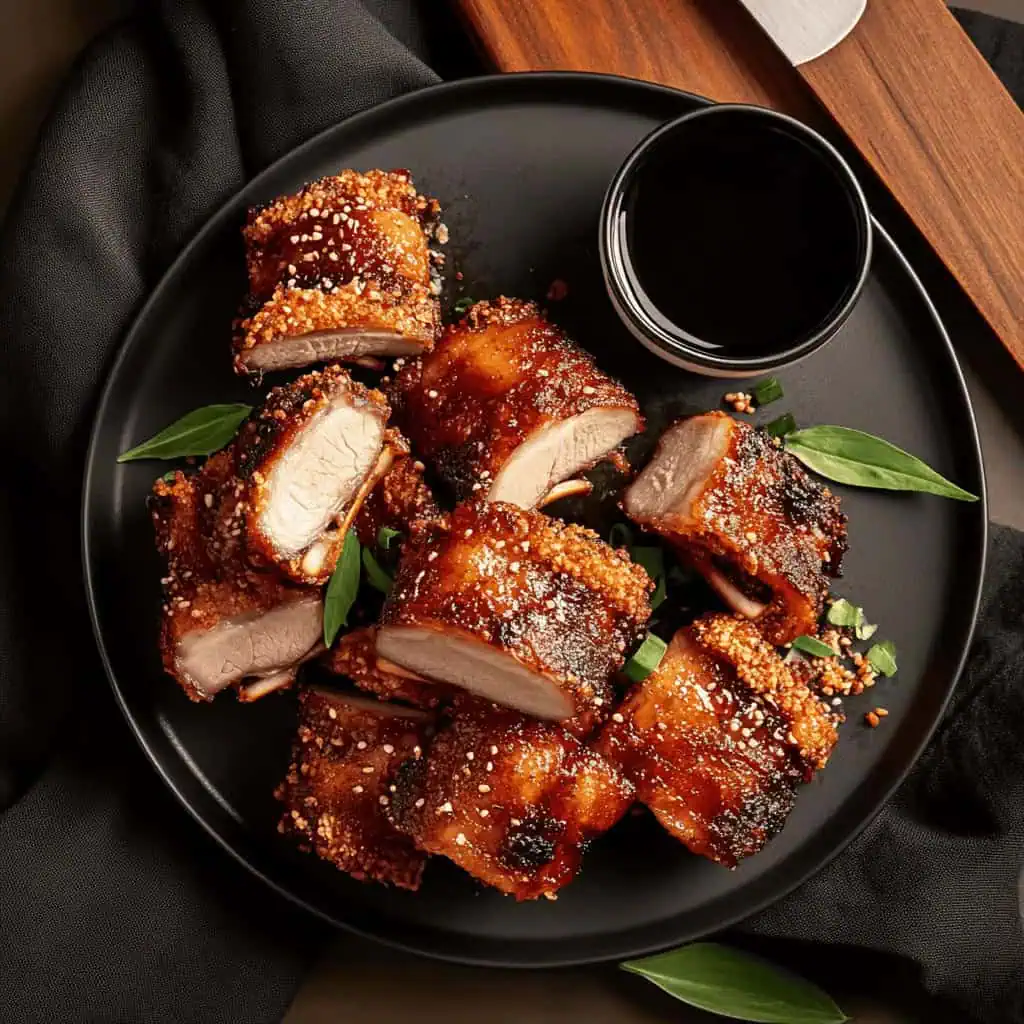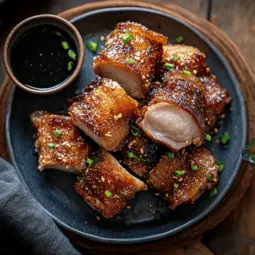Every Filipino family has that one special occasion when the familiar sound of oil crackling fills the air, and everyone rushes to the kitchen asking, "Ma, may Crispy Pata ba?" From birthday celebrations at home to weekend family gatherings where your Titas can't stop taking pictures for their Facebook, this golden-brown beauty has always been the star of the show.
Whether you're fighting over the crunchiest skin part (we all know that's the best), or secretly hoping to take home the leftovers (if there are any), Crispy Pata isn't just ulam, it's a celebration on a plate.
Today, I'm sharing our family's tried-and-tested Filipino Crispy Pata recipe, the same one that my Lola perfected after years of cooking for our huge extended family. No need to wait for fiestas or special occasions anymore!
With some patience and lots of care when deep frying, you can recreate this crispy, juicy masterpiece that will have your family gathering around the table faster than you can say "Masarap."
Jump to:

Why You'll Love This Recipe
- Foolproof Method: Our three-stage cooking process ensures perfect results every time
- Restaurant Quality: Achieve that coveted crackling skin that rivals your favorite Filipino restaurant
- Family Tested: Perfected through generations of Filipino family celebrations
- Detailed Guide: Complete with temperatures, timing, and troubleshooting
- Make-Ahead Friendly: Can be prepared in stages for convenient cooking
Ingredients
This recipe combines carefully selected ingredients that work together for perfect Crispy Pata. The vinegar and citrus from 7-Up help tenderize the tough pork leg while eliminating any gamey flavor.
Garlic, peppercorns, and bay leaves infuse the meat during the slow-cooking process, creating layers of flavor that penetrate deep into the tissue. Rock salt not only seasons the meat but also draws moisture from the skin, the secret to achieving that glass-like crackling.
For the dipping sauce, the balance of sharp vinegar, umami-rich soy sauce, and aromatic alliums cuts through the richness of the pork, while Thai chilies add heat that stimulates the palate, making each bite more satisfying than the last.

For the Pork:
- 1 whole pork leg, 3-4 kg (pata ng baboy)
- 1 cup white vinegar
- 1 can (12 oz) 7-Up/Sprite
- 1 whole garlic head, crushed
- 2 tablespoons whole peppercorns
- 4 bay leaves
- 3 tablespoons rock salt
- 5-6 cups cooking oil
For the Spiced Vinegar Dip (Sawsawan):
- 1 cup white vinegar
- ¼ cup soy sauce
- 4 shallots, minced
- 5 garlic cloves, minced
- 3 Thai chilies, chopped
- ½ teaspoon ground pepper
Equipment
- Large heavy-bottomed pot: Essential for boiling the pork leg with aromatics until tender. The heavy bottom ensures even heat distribution and prevents burning.
- Deep-fry thermometer: Crucial for maintaining the perfect oil temperature (175°C/350°F) to achieve that golden crispy skin.
- Kitchen torch: Used to remove any remaining hair from the skin, ensuring a perfectly smooth surface for crackling.
- Wire rack: Allows air circulation during the drying process and when draining excess oil after frying.
- Sharp cleaver: Necessary for chopping the crispy pata into serving pieces without shattering the delicate crispy skin.
- Splatter screen: Protects from hot oil splatters during the deep-frying process.
- Long tongs: Provides safe distance when handling the pork leg in hot oil.
- Large tray or baking sheet: For refrigerating the pork leg during the crucial drying stage.

How To Make
- Start your preparation one day before you plan to serve. First, clean your pork leg thoroughly under running water. Using kitchen torch, carefully remove any remaining hair from the skin. Pat the pork leg dry with paper towels.
- Take your large pot and place the pork leg inside. Pour in one cup of white vinegar, one can of lemon-lime soda, and add the crushed whole garlic head, whole peppercorns, bay leaves, and two tablespoons of rock salt. Add enough water to fully cover the pork.
- Set your stove to high heat and bring the liquid to a full boil at 100°C/212°F. Once boiling, lower the heat to medium-low, maintaining a temperature between 85-90°C (185-195°F). Let the pork simmer for about 1.5 to 2 hours. You'll know it's ready when you can easily pierce the meat with a fork, but it shouldn't be falling apart.
- Remove the pork leg from the liquid and let it drain completely. Using paper towels, pat the entire surface very dry, paying special attention to the skin. Take the remaining tablespoon of rock salt and rub it all over the skin.
- Place the pork leg on a wire rack with the skin facing up. Put it in the refrigerator, uncovered, and let it dry for 8-12 hours or overnight at 4°C/40°F. This drying step is crucial for achieving crackling skin.
- One hour before cooking, remove the pork from the refrigerator and let it come to room temperature. Meanwhile, prepare your dipping sauce. In a bowl, combine white vinegar, soy sauce, minced shallots, minced garlic, chopped Thai chilies, and ground black pepper. Mix well and set aside.
- Pour cooking oil into a large, heavy-bottomed pot - you'll need enough oil to submerge half of the pork leg. Heat the oil to 175°C/350°F. If you don't have a thermometer, test the oil by dropping a small piece of bread - it should turn golden brown within 30 seconds.
- Very carefully lower the pork leg into the hot oil using long tongs or a spider strainer. The oil will bubble vigorously - this is normal. Keep the oil temperature between 160-175°C (320-350°F). Cook for 20-30 minutes, maintaining consistent heat and occasionally rotating the pork leg for even cooking. The skin should turn a deep golden brown and become very crispy.
- Remove the pork leg from the oil when the skin is crispy and golden. Let it rest on a wire rack for 10 minutes to drain excess oil and allow the meat to settle. When tapped, the skin should sound hollow and crack like candy.
- Using a sharp cleaver, carefully chop the crispy pata into serving pieces. Serve immediately while the skin is at its crispiest, accompanied by the spiced vinegar dipping sauce and steaming white rice.

Tips from Lola's Kitchen
Choose your pork leg wisely:
- Front leg (shoulder) has more fat and flavor
- Back leg (ham) is meatier and larger
- Look for skin without blemishes or cuts for a perfect crackling
- Ask your butcher to clean and prepare the leg, but inspect it yourself for remaining hair
For the crispiest skin:
- Ensure the skin is absolutely dry before refrigerating
- Blot multiple times with paper towels
- The salt rub helps draw out remaining moisture
- Don't cover the pork in the refrigerator - air circulation is essential
- Let the pork come to room temperature before frying
- Maintain consistent oil temperature - too hot will burn the skin, too cool will make it soggy
Boiling technique secrets:
- The lemon-lime soda helps tenderize the meat
- Vinegar eliminates any unwanted odors and adds flavor depth
- Keep the simmer gentle to avoid tough meat
- Test doneness by piercing with a fork in multiple places
Oil and frying safety:
- Use a deep pot with plenty of headspace to prevent overflow
- Keep a fire extinguisher nearby
- Never leave hot oil unattended
- Use long tongs for handling the pork leg
- Turn off the heat immediately if oil starts smoking
- Work with a partner if possible - one person to lower the pork leg, another to monitor temperature
Substitutions
Pork Leg Alternatives:
- Pork belly (reduce cooking time by 30 minutes)
- Pork shoulder cut into smaller portions (reduce cooking time accordingly)
- Pork knuckles (adjust cooking time to about 1.5 hours)
Lemon-Lime Soda Substitutes:
- Beer (adds maltiness)
- Apple juice with 1 tablespoon lemon juice
- Plain water with 2 tablespoons sugar and 1 tablespoon lemon juice
- Pineapple juice (adds natural tenderizing enzymes)
Vinegar Options:
- Cane vinegar (traditional and preferred)
- White vinegar (clean, sharp flavor)
- Apple cider vinegar (milder with slight sweetness)
- Coconut vinegar (authentic Filipino flavor)
Dipping Sauce Variations:
- Add grated green mango for tanginess
- Substitute calamansi juice for some of the vinegar
- Use brown sugar for a sweet-sour balance
- Add chopped tomatoes for freshness
Troubleshooting
Skin not crisping properly:
- Problem: Insufficient drying time
- Solution: Ensure surface is completely dry before frying, extend refrigeration time to 24 hours if needed
- Problem: Oil temperature too low
- Solution: Maintain proper oil temperature using a thermometer, adjust heat as needed
- Problem: Wet spots on skin
- Solution: Pat dry multiple times during preparation, focus on crevices and joints
Meat too tough:
- Problem: Insufficient boiling time
- Solution: Extend boiling time by 30-minute increments until fork-tender
- Problem: Boiling temperature too high
- Solution: Keep liquid at a gentle simmer, not a rolling boil
- Problem: Poor quality meat
- Solution: Choose younger pork legs with good marbling
Oil splattering excessively:
- Problem: Moisture in or on the pork
- Solution: Ensure pork is completely dry and at room temperature
- Problem: Oil too hot
- Solution: Reduce temperature slightly, use a splatter guard
- Problem: Pot too small
- Solution: Use a larger, deeper pot with more headspace
Skin burns before meat warms through:
- Problem: Oil temperature too high
- Solution: Reduce to 160°C/320°F
- Problem: Cold meat interior
- Solution: Ensure pork reaches room temperature before frying
- Problem: Uneven heat distribution
- Solution: Rotate pork more frequently
Storage & Reheating
Storage Instructions:
- Refrigerate leftovers within 2 hours of cooking
- Separate meat from skin if possible before storing
- Store in airtight containers for up to 3 days
- Can be frozen for up to 1 month (skin quality will diminish)
- Wrap tightly in plastic wrap, then foil before freezing
Reheating Methods:
Oven Method (Best for preserving crispy skin):
- Preheat oven to 400°F (200°C)
- Place crispy pata pieces on a wire rack over a baking sheet
- Heat for 15-20 minutes until warmed through
- Watch carefully to prevent burning
Air Fryer Method:
- Preheat air fryer to 370°F (188°C)
- Arrange pieces without overcrowding
- Heat for 5-7 minutes
- Check frequently to prevent burning
Avoid Microwave Reheating:
- Microwaving will make the skin soft and rubbery
- If necessary, microwave only the meat portions

FAQ
Can I prepare crispy pata in advance for a party?
Yes! Complete the boiling and drying stages up to 2 days ahead, keeping the dried pork leg refrigerated. Deep fry just before serving for the freshest results.
How do I know when the oil is hot enough without a thermometer?
Insert a wooden chopstick or spoon handle into the oil - small bubbles should form around it immediately. Alternatively, drop a small piece of bread in the oil - it should turn golden brown in 30 seconds.
Is it safe to freeze the cooked pork leg?
Yes, but separate the meat from the skin before freezing to maintain texture. The skin will never be quite as crispy after freezing, but the meat freezes well.
How many people does one pork leg serve?
One 4-5 kg leg typically serves 6-8 people as a main dish with rice and sides. For larger gatherings, prepare two legs or supplement with other dishes.
Can I reuse the frying oil?
Yes, strain through a fine-mesh sieve lined with cheesecloth while still warm (but not hot). Store in a clean, airtight container away from light and heat. Use up to 2-3 times for similar dishes.
What's the secret to keeping the meat moist while getting crispy skin?
The three-stage cooking process: proper simmering until tender, thorough drying, and careful temperature control during frying. The resting time after frying also helps redistribute juices.
Can I make a healthier version of crispy pata?
While traditional deep-frying yields the best results, you can try an oven method. After boiling and drying, brush with oil and bake at 400°F for one hour, then increase to 450°F for the final 30 minutes.
What if I don't have time for overnight drying?
While overnight drying yields the best results, in a pinch, you can use your oven's lowest setting (around 170°F/77°C) with the door slightly ajar for 2-3 hours to speed up the drying process.
Related
Looking for other recipes like this? Try these:

Filipino Crispy Pata (Crispy Pork Leg)
Equipment
- Large heavy-bottomed pot (malaking kaldero)
- Deep-fry thermometer (termometro)
- Kitchen torch (pangsunog ng balat)
- Wire rack (cooling rack)
- Sharp cleaver (malaking kutsilyo)
- Splatter screen (pangsangga sa mantika)
Ingredients
For the Pork
- 1 whole pork leg 3-4 kg (pata ng baboy)
- 1 cup white vinegar suka
- 1 can 12 oz 7-Up/Sprite
- 1 whole garlic head crushed (isang ulong bawang)
- 2 tablespoons whole peppercorns paminta
- 4 bay leaves dahon ng laurel
- 3 tablespoons rock salt asin
- 5-6 cups cooking oil mantika
For the Spiced Vinegar Dip (Sawsawan)
- 1 cup white vinegar suka
- ¼ cup soy sauce toyo
- 4 shallots minced (sibuyas tagalog)
- 5 garlic cloves minced (bawang)
- 3 Thai chilies chopped (siling labuyo)
- ½ teaspoon ground pepper dinurog na paminta
Instructions
- Start your preparation one day before you plan to serve. First, clean your pork leg (pata ng baboy) thoroughly under running water. Using kitchen torch, carefully remove any remaining hair (balahibo) from the skin. Pat the pork leg dry with paper towels.
- Take your large pot (malaking kaldero) and place the pork leg inside. Pour in one cup of white vinegar (suka), one can of lemon-lime soda, and add the crushed whole garlic head (dinurog na isang ulong bawang), whole peppercorns (paminta), bay leaves (dahon ng laurel), and two tablespoons of rock salt (asin). Add enough water to fully cover the pork.
- Set your stove to high heat and bring the liquid to a full boil (kumukulo) at 100°C/212°F. Once boiling, lower the heat to medium-low, maintaining a temperature between 85-90°C (185-195°F). Let the pork simmer (pakuluan) for about 1.5 to 2 hours. You'll know it's ready when you can easily pierce the meat with a fork (malambot na), but it shouldn't be falling apart.
- Remove the pork leg from the liquid and let it drain completely. Using paper towels, pat the entire surface very dry, paying special attention to the skin. Take the remaining tablespoon of rock salt and rub it all over the skin (pahiran ng asin ang balat).
- Place the pork leg on a wire rack with the skin facing up. Put it in the refrigerator, uncovered, and let it dry for 8-12 hours or overnight at 4°C/40°F. This drying step (pagpapatuyo) is crucial for achieving crackling skin.
- One hour before cooking, remove the pork from the refrigerator and let it come to room temperature. Meanwhile, prepare your dipping sauce (sawsawan). In a bowl, combine white vinegar, soy sauce (toyo), minced shallots (sibuyas tagalog), minced garlic (bawang), chopped Thai chilies (siling labuyo), and ground black pepper (dinurog na paminta). Mix well and set aside.
- Pour cooking oil (mantika) into a large, heavy-bottomed pot - you'll need enough oil to submerge half of the pork leg. Heat the oil to 175°C/350°F. If you don't have a thermometer, test the oil by dropping a small piece of bread - it should turn golden brown within 30 seconds.
- Very carefully lower the pork leg into the hot oil using long tongs or a spider strainer. The oil will bubble vigorously (bubula) - this is normal. Keep the oil temperature between 160-175°C (320-350°F). Cook for 20-30 minutes, maintaining consistent heat and occasionally rotating the pork leg for even cooking. The skin should turn a deep golden brown and become very crispy (malutong).
- Remove the pork leg from the oil when the skin is crispy and golden. Let it rest on a wire rack for 10 minutes to drain excess oil and allow the meat to settle. When tapped, the skin should sound hollow and crack like candy.
- Using a sharp cleaver (malaking kutsilyo), carefully chop the crispy pata into serving pieces. Serve immediately while the skin is at its crispiest, accompanied by the spiced vinegar dipping sauce and steaming white rice (mainit na kanin).
- If you have leftovers, store them in an airtight container in the refrigerator for up to three days. To reheat, place in a preheated oven at 200°C/400°F for 15-20 minutes to restore the skin's crispiness (para maging malutong ulit).
Tips from Lola's Kitchen
- Choose your pork leg wisely:
- Front leg (shoulder) has more fat and flavor
- Back leg (ham) is meatier and larger
- Look for skin without blemishes or cuts
- For the crispiest skin:
- Ensure the skin is completely dry before frying
- Score the skin properly without cutting into meat
- Keep refrigerated uncovered to dry the skin
- Maintain proper oil temperature
- Safety first:
- Use a deep pot with plenty of headspace
- Keep a fire extinguisher nearby
- Never leave hot oil unattended
- Use long tongs for handling
Nutrition
The Story Behind Crispy Pata (Crispy Pork Leg)
Crispy Pata, the beloved Filipino pork leg dish that has captured hearts worldwide, represents the pinnacle of Filipino culinary craftsmanship. This iconic dish transforms a humble cut of pork into a masterpiece of contrasting textures – featuring glass-like crackling skin that shatters at the touch and incredibly tender, juicy meat within. What began as a clever way to use every part of the pig has evolved into one of the Philippines' most celebrated festival dishes.
In the bustling streets of Manila during the 1950s, local eateries began experimenting with deep-frying tender, boiled pork legs, inspired by the Chinese cooking techniques that had influenced Filipino cuisine for centuries. The combination of slow-cooking methods passed down through generations of Filipino families and the addition of a crispy exterior created something entirely new – a dish that would become a national treasure.
The genius behind Crispy Pata lies in its three-stage cooking process, a method that showcases the sophistication of Filipino cooking techniques. First, the pork leg is gently simmered with native aromatics like garlic, peppercorns, and bay leaves, a process locally known as "pagpapalambot." This crucial step infuses the meat with deep flavors while ensuring fork-tender results. The subsequent overnight drying, or "pagpapatuyo," is a technique that local chefs discovered was essential for achieving that coveted crackling skin. The final deep-frying stage, "pagpiprito," requires the skill and patience that distinguishes great Filipino cooks from good ones.
What makes Filipino Crispy Pata truly special is its role in Filipino culture. When a Filipino family orders Crispy Pata at a restaurant or prepares it at home, it's never just about the food – it's a celebration in itself. The dish has become synonymous with "handaan" (festivities), from family reunions to milestone celebrations. The ritual of gathering around a freshly-cooked Crispy Pata, hearing the satisfying crack of the skin as it's chopped, and sharing the various choice parts among family members is a cherished tradition that spans generations.
The accompanying sawsawan (dipping sauce) is not merely a condiment but a crucial component that completes the Crispy Pata experience. The traditional mixture of vinegar, soy sauce, garlic, chili, and onions provides the perfect tangy counterpoint to the rich, fatty meat. This balance of flavors – the interplay between richness and acidity – is a defining characteristic of Filipino cuisine.
Modern Filipino chefs have embraced Crispy Pata while respecting its traditional preparation methods. From humble carinderias (local eateries) to upscale Filipino restaurants in major cities worldwide, each establishment takes pride in its version of this classic dish. Some add their own twists, like special spice blends in the boiling liquid or unique dipping sauce combinations, but the essence remains the same – that perfect contrast between crispy and tender.
Today, Crispy Pata has transcended its origins to become a benchmark of Filipino cooking expertise. Food critics and enthusiasts often judge a Filipino restaurant's quality by its Crispy Pata – the transparency of the skin, the tenderness of the meat, and the overall execution of this technically challenging dish. Its popularity has spread beyond Filipino communities, with food lovers worldwide seeking out this impressive dish that perfectly represents the complexity and sophistication of Filipino cuisine.
The dish's enduring popularity in the age of health-conscious dining speaks to its special place in Filipino culture. While it may be reserved for special occasions, the joy of sharing a perfectly-cooked Crispy Pata with loved ones makes it a worthy indulgence. Each bite tells a story of Filipino culinary heritage, family celebrations, and the artistry of Filipino cooks who have perfected this dish over generations.
Whether served in a humble neighborhood eatery or a high-end restaurant, Crispy Pata remains a testament to the Filipino talent for transforming simple ingredients into extraordinary dishes. It's more than just a meal – it's a celebration of Filipino creativity, family togetherness, and the enduring appeal of traditional cooking methods in modern times.
Remember: Perfect crispy pata isn't just about the crackly skin—it's about achieving that precise balance where the exterior shatters like glass while the meat remains moist and tender, paired with a dipping sauce that brings all the flavors together.










Comments
No Comments